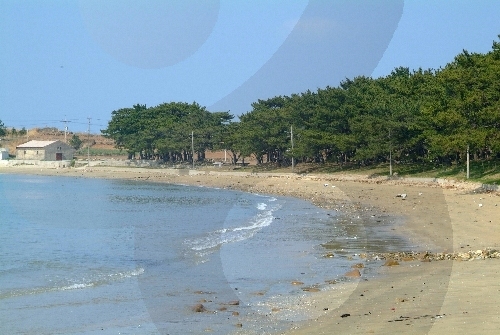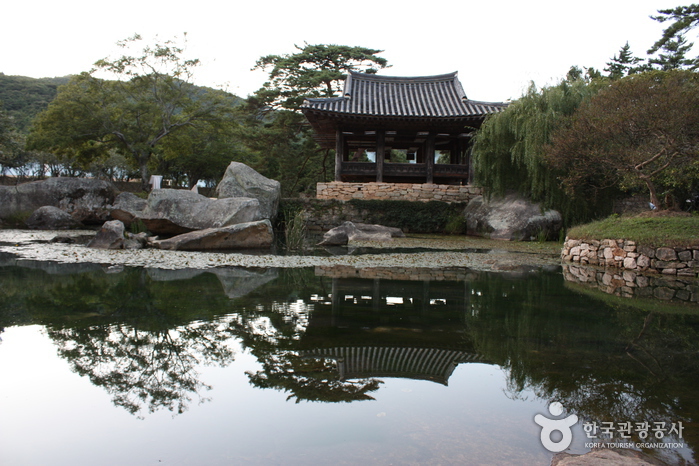Maryang Port (마량미향(마량항))
19.5Km 2024-02-16
150 Mihang-ro, Maryang-myeon, Gangjin-gun, Jeollanam-do
Maryang Port, situated along the pristine waters linking Wando Island, the Dadohae islands, and Jeju, is a notable destination. From April to October, it becomes the venue for the Maryang Nolto Fish Market every Saturday. This market is celebrated for its lavish food selections and the spectacle of raw fish being expertly sliced before visitors. Adjacent to the port, an observatory provides sweeping views of the stunning Gangjin seas. Additionally, the nearby Kkamakseom Island, recognized as a Natural Monument, is visible from this vantage point, adding to the area's allure.
Jiri Beach (지리해수욕장)
19.8Km 2021-07-14
1462-58, Cheongsan-ro, Wando-gun, Jeollanam-do
+82-61-550-6495
Jiri Beach offers a beautiful view of the sunset and is regarded as one of the best beaches on Cheongsando Island. With its clean, shallow waters and fine white sand, it is a great vacation spot for families. The beach stretches for 1 kilometer, is 100 meters in x_width, and is bordered by over 500 ancient pine trees that provide natural shade from the sun. The waters of Cheongsando Island teem with fish, earning the island a reputation as one of Korea’s major sea fishing sites.
Daeheungsa Temple [UNESCO World Heritage] (대흥사[유네스코 세계문화유산])
19.9Km 2025-09-04
400, Daeheungsa-gil, Samsan-myeon, Haenam-gun, Jeollanam-do
+82-61-534-5502
Daeheungsa Temple, located on Duryunsan Mountain, is said to have been founded by Monk Ado in the 22nd year of King Seong of Baekje. In 2018, it was inscribed on the UNESCO’s World Heritage List as part of the “Sansa, Buddhist Mountain Monasteries in Korea.” Also known as a temple where the spirit of Buddhism for national protection remains alive, Daeheungsa Temple served as the main base for monk soldiers led by Seosan Daesa during the Japanese invasions of Korea. Later, Seon Master Choui, who believed that the truth of the Buddha and the joy of meditation could be found in tea, built Iljiam Hermitage in the valley of Daeheungsa Temple. There, he devoted himself to solitary practice for more than 40 years, earning the temple recognition as a sacred site of Korea’s tea culture. Situated in a wide mountain basin, Daeheungsa Temple displays a unique layout. Geumdangcheon Stream runs through the grounds, dividing the buildings into North and South Precincts. Unlike standard temple layouts, these buildings are arranged freely, creating a distinctive spatial composition. Set farther back behind the South Precinct are the Pyochungsa Shrine, dedicated to Seosan Daesa, and Daegwangmyeonjeon Hall within Donggukseonwon Temple. Among the treasures of the temple is the Rock‑carved Seated Buddha at Bungmireugam Hermitage, designated as a National Treasure. Seosan Daesa Relics Hall houses 24 cultural artifacts, including royal gifts from King Seonjo, such as a jade alms bowl and a jadeite (green jade) alms bowl, along with Seosan Daesa’s calligraphy, sedan chair, shoes, and Buddhist scriptures written in gold and silver.
Bogildo Island Seyeonjeong Pavilion (보길도 세연정)
19.9Km 2021-12-23
57, Buhwang-gil, Wando-gun, Jeollanam-do
+82-61-550-5761
Yun Seon-do (1587~1671), a non-military civil administrator and poet in the mid Joseon dynasty, could hardly contain his anger after hearing the news that the king had surrendered during the Byeongjahoran War (Chinese invasion of Korea in 1636). Following the events, he decided to live in seclusion by moving to Jeju Island. However, on the way to Jeju, he came across Bogildo Island and he was so inspired by its beauty that he ended up settling down on Bogildo instead.
For the following 13 years, he composed great poems such as "Eobusasisa (Fisherman's Song for Four Seasons)." Some of the mountain peaks and rocks named by him still remain on the island.
Seyeonjeong Pavilion was built by Yun Seondo and this is the birthplace of his literary works. On clear days, he would come to the pavilion with his family and let singers sing his verses.
Bogildo Island embraces both the Eastern outlook on nature and Neo-Confucianism ideology. While going around the island, visitors will get some semblance of how Yun Seondo harmonized man and nature through the combination of the island's natural and the man-made features.


![Daeheungsa Temple [UNESCO World Heritage] (대흥사[유네스코 세계문화유산])](http://tong.visitkorea.or.kr/cms/resource/09/1929609_image2_1.jpg)

 English
English
 한국어
한국어 日本語
日本語 中文(简体)
中文(简体) Deutsch
Deutsch Français
Français Español
Español Русский
Русский